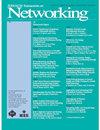最大限度降低无损数控系统间链路的缓冲区利用率
IF 3.6
3区 计算机科学
Q2 COMPUTER SCIENCE, HARDWARE & ARCHITECTURE
引用次数: 0
摘要
RDMA over Converged Ethernet (RoCEv2)因其与以太网/IP的兼容性优于IB (Infiniband)而被广泛部署到数据中心。随着跨数据中心应用的出现,对跨数据中心数据传输的高吞吐量、低延迟和无损网络提出了更高的要求。然而,RoCEv2的底层无损机制基于优先级的流量控制(PFC)不适合长途传输场景,并降低了RoCEv2的性能。PFC是短视的,它只考虑队列长度来暂停上游发送方,这导致了很大的队列延迟。本文提出了Bifrost,一种支持长距离跨直流数据传输的下游驱动的无损流量控制。Bifrost采用虚拟入方向报文(即报文流的上限值)和缓冲报文来控制流量。它最大限度地减少了对一跳带宽延迟积(BDP)的缓冲空间需求,实现了较低的单向延迟。此外,我们扩展了Bifrost并提出了BifrostX,以适应当前交换机实现的多优先级队列。BifrostX支持对每个队列分别进行流控制,同时保持较低的缓冲区保留,没有吞吐量损失和数据包丢失。现实世界的实验是用原型开关和80公里长的电缆进行的。评估表明,与PFC相比,Bifrost可将直流间流的平均/尾流完井时间(FCT)分别减少22.5%和42.0%。Bifrost与现有基础设施兼容,可以支持数千公里的距离。本文章由计算机程序翻译,如有差异,请以英文原文为准。
Minimizing Buffer Utilization for Lossless Inter-DC Links
RDMA over Converged Ethernet (RoCEv2) has been widely deployed to data centers (DCs) for its better compatibility with Ethernet/IP than Infiniband (IB). As cross-DC applications emerge, they also demand high throughput, low latency, and lossless network for cross-DC data transmission. However, RoCEv2’s underlying lossless mechanism Priority-based Flow Control (PFC) cannot fit into the long-haul transmission scenario and degrades the performance of RoCEv2. PFC is myopic and only considers queue length to pause upstream senders, which leads to large queueing delay. This paper proposes Bifrost, a downstream-driven lossless flow control that supports long distance cross-DC data transmission. Bifrost uses virtual incoming packets, which indicates the upper bound of in-flight packets, together with buffered packets to control the flow rate. It minimizes the buffer space requirement to one-hop bandwidth delay product (BDP) and achieves low one-way latency. Moreover, we extend Bifrost and propose BifrostX, to accommodate the multi-priority queue of the current switch implementation. BifrostX enables flow control for each queue separately while maintaining low buffer reservation, no throughput loss, and no packet loss. Real-world experiments are conducted with prototype switches and 80 kilometers cables. Evaluations demonstrate that compared to PFC, Bifrost reduces average/tail flow completion time (FCT) of inter-DC flows by up to 22.5%/42.0%, respectively. Bifrost is compatible with existing infrastructure and can support distance of thousands of kilometers.
求助全文
通过发布文献求助,成功后即可免费获取论文全文。
去求助
来源期刊

IEEE/ACM Transactions on Networking
工程技术-电信学
CiteScore
8.20
自引率
5.40%
发文量
246
审稿时长
4-8 weeks
期刊介绍:
The IEEE/ACM Transactions on Networking’s high-level objective is to publish high-quality, original research results derived from theoretical or experimental exploration of the area of communication/computer networking, covering all sorts of information transport networks over all sorts of physical layer technologies, both wireline (all kinds of guided media: e.g., copper, optical) and wireless (e.g., radio-frequency, acoustic (e.g., underwater), infra-red), or hybrids of these. The journal welcomes applied contributions reporting on novel experiences and experiments with actual systems.
 求助内容:
求助内容: 应助结果提醒方式:
应助结果提醒方式:


